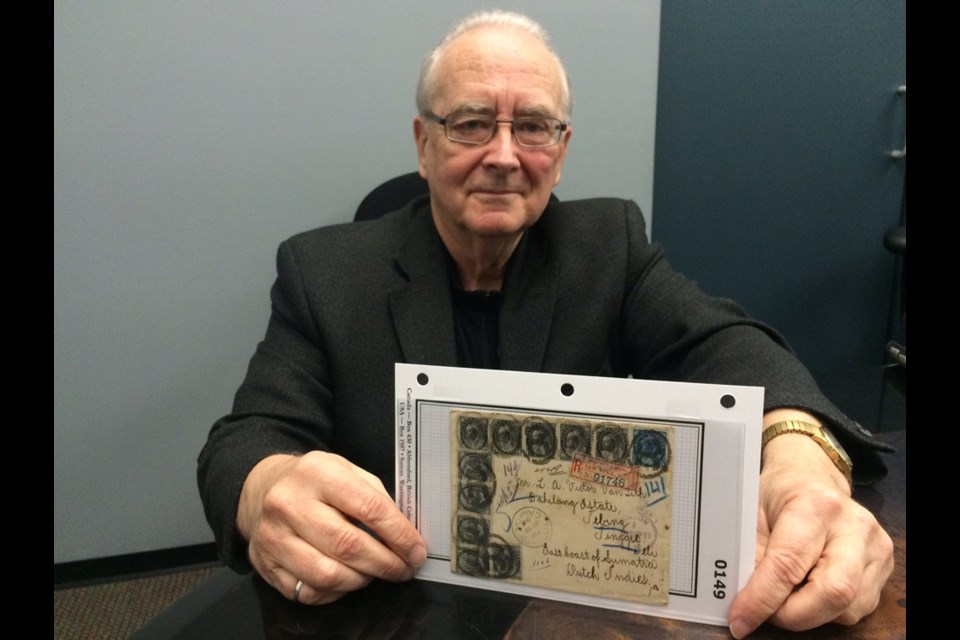Ron Leith is officially a stamp collector, but in practice, he’s more like a treasure hunter.
The Chilliwack resident worked in the oil industry, retired in his 40s and started running stamp auctions to finance his own collecting hobby.
Leith is auctioning items off during Richpex, Western Canada’s largest stamp auction, and it takes place right here in Burnaby. Leith brought some of the most valuable items up for auction to the NOW office for a little show-and-tell session.
What originally got you interested in collecting stamps?
My uncle, when I was about 10 years old. Showed me a collection of stamps he was collecting, it was modern Canada plate blocks, and I looked at them and I thought those are really neat, and it got my interest up. I immediately started collecting them.
And what was it about them that you found intriguing?
They were pretty and you could organize them, and you could fill all the spaces. … By the time I hit 14 I found out there was such a thing as girls in the world. I dropped stamp collecting like a hot potato. I got involved in business and management, fairly high positions in various companies. By the time I was about 35 to 40, there was a lot of pressure. …. And I really needed an escape from all of that, and I remembered my stamp collecting. I went back to it, and it was absolutely, completely relaxing.
How many stamps have you collected personally?
Probably a million.
Are you serious? How could you have a million stamps? Where would you keep them all?
Many rooms.
What’s your net worth in stamps?
I can’t tell you that. I know what it is. I don’t want the bad guys to be showing up on my doorstep. I do have a vault and all that kind of stuff, for valuable items.
You basically have half a museum in your house in Chilliwack.
And the other half is the library that’s associated with it.
Tell me about the thrill of the hunt and how that’s the best part of going to a show.
There was a beautiful example, recently: There were only two known copies of a two-cent Canadian stamp from 1868 that had what is known as laid paper, a certain kind of paper, when you hold it up to the light, you can see lines in it. There are only two copies known. So these were selling at $50,000 to $75,000 a piece.
Holy, that’s a lot of money.
One way you can get stamps, is you apply to different societies and they will send you a circuit book. And there will be all kinds of stamps that other collectors aren’t interested in that they want to sell, and you go through and pick out the ones you want, and you send a cheque for the amount that’s one there. And you send the books back. Well this guy pulled this two cent stamp out of the book, he looked at it, and it had laid lines on it. It’s the best copy known. It’s a dated copy. It has the town cancel on it with the actual date on it - 1870 date on it. And it sold for $200,000. He bought that stamp for $6.
What was your biggest score?
I went to an auction in California, I bid on a collection of Canadian stamps. I expected to pay $7,000, $8,000, $9,000 for it. It opened on the floor at $2,700. Of course, I put my paddle up, $2,800. And nobody else bid on it. And I almost fell on the floor. I bought it for $2,800 plus commission.
Maybe they just didn’t appreciate how valuable the Canadian stamps were.
Well, let me tell you. When I got it home, I went through, and there was one of those Number Tens in there, … and it had four big margins on it. So that’s $9,000 right there.
So you’ve already recovered your investment.
Many times over. When I actually went through, and I calculated the actual value of that collection, it came up at $120,000.
Holy! That’s incredible.
If I do one of those a year, this will keep me in stamp collecting the rest of my life. And I do that once a year.
Want to get in on the action? Richpex takes place March 18 to 20 at the Executive Suites Hotel and Conference Centre, 4201 Lougheed Hwy. Auction viewing times: Friday, March 18, 10 a.m. to 9 p.m., Saturday, March 19, 9 a.m. to 5 p.m., Sunday, March 20, 9 a.m. to noon. Info: stampauctionnetwork.com/zi/zi48.cfm.
Stamp collecting vocabulary:
Cover: An envelope cover usually with a stamp on it.
Cancel: When a postal employee rubber stamps an envelope’s stamp to show it has been used. Many cancels include important information like dates and locations.
Kiss print: Also known as a double print. When a stamp is printed twice, in error, so that the image is slightly off because of the second impression.
Laid lines: Lines seen on laid paper, which has a slightly ribbed surface. Laid paper was common in the 19th century.



